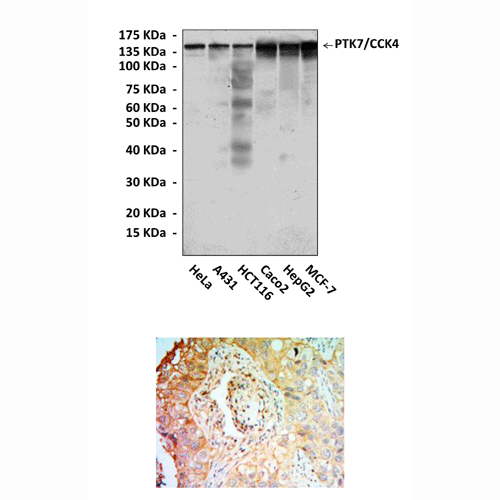Anti-PTK7/CCK4: Mouse PTK7/CCK4 Antibody |
 |
BACKGROUND PTK7 (protein tyrosine kinase 7) (also known as CCK4) is a transmembrane protein and is similar to the receptor protein-tyrosine kinase family of proteins, with seven extracellular immunoglobulin-like domains, a single transmembrane motif and an intracellular kinase homology domain. However, the kinase homology domain lacks the DFG triplet that is necessary for the chelation of Mg2+ during phosphotransfer and required for kinase activity.1 PTK7/CCK4 is therefore thought to encode a pseudokinase, lacking catalytic function. Although other proteins lacking the DFG motif have been found to have kinase activity through the use of an alternative motif, experimental evidence confirms that mammalian PTK7/CCK4 lacks kinase activity and is not phosphorylated in cell culture. PTK7/CCK4 orthologues in Hydra (Lemon) and chicken (KLG) also lack kinase activity. In contrast, the Drosophila homologue of PTK7/CCK4 (Off-track, Otk, previously named Dtrk), mediates calcium-dependent homophilic binding, and is phosphorylated on tyrosine residues in cultured cells. Human PTK7/CCK4 encodes five alternatively spliced variants. Mouse PTK7/CCK4 has two isoforms, of approximately 100 and 140 kDa that may be resulted from juxtamembrane cleavage of PTK7/CCK4. PTK7/CCK4 has been proposed to be part of an unusual receptor tyrosine kinase signaling mechanism involving transmembrane domain-mediated interactions rather than kinase activity, or to mediate signal attenuation. The transmembrane domains of the PTK7/CCK4 family are unusually highly conserved, across evolution, and this has been argued to support an important role for this domain. Notably, the kinase-like domain of Xenopus PTK7/CCK4 is required for the physical interaction of PTK7/CCK4 with disheveled.2 Disheveled (dsh) is a key regulator of both the canonical as well as the PCP signaling pathway and regulates cell fate specification as well as cell movements such as convergent extension. Dsh consists of three major conserved domains, the DIX, PDZ and DEP domain, which have been implicated in different downstream signaling events. It was shown that PTK7/CCK4 recruits disheveled (dsh) to the plasma membrane, a function that is dependent on the PDZ domain of dsh, as well as on the conserved kinase domain of PTK7/CCK4. Furthermore, endogenous PTK7/CCK4 is required for frizzled7-mediated dsh localization. PTK7/CCK4 cooperates with frizzled to localize dsh. Thus, PTK7/CCK4 regulates neural crest migration by recruiting dsh. The planar cell polarity (PCP) signaling pathway is fundamental to a number of key developmental events, including initiation of neural tube closure. Disruption of the PCP pathway causes the severe neural tube defect of craniorachischisis, in which almost the entire brain and spinal cord fails to close.3 PTK7 is a regulator of planar cell polarity (PCP) signaling that could modulate the dsh localization as well as the interaction with pathway-specific effector proteins. PTK7/CCK4 regulates PCP in the inner ear hair cells and during neural tube closure in mice. Moreover, PTK7/CCK4 is an essential regulator of mediolateral cell intercalation during mammalian convergent extension.4
REFERENCES
1. Liu, X. et al: Nature 430:93-8, 2004
2. Shnitsar, I. & Borchers, A.:Develop. 135:4015-24, 2008
3. Paudyal, A. et al: BMC Dev. Biol. 10:87, 2010
4. Yen, W.W. et al: Develop. 136:2039–48, 2009
2. Shnitsar, I. & Borchers, A.:Develop. 135:4015-24, 2008
3. Paudyal, A. et al: BMC Dev. Biol. 10:87, 2010
4. Yen, W.W. et al: Develop. 136:2039–48, 2009
Products are for research use only. They are not intended for human, animal, or diagnostic applications.
Параметры
Cat.No.: | CP10316 |
Antigen: | Raised against recombinant human PTK7/CCK4 fragments expressed in E. coli. |
Isotype: | Mouse IgG1 |
Species & predicted species cross- reactivity ( ): | Human, Mouse, Rat |
Applications & Suggested starting dilutions:* | WB 1:1000 IP n/d IHC 1:50 - 1:200 ICC n/d FACS n/d |
Predicted Molecular Weight of protein: | 140 kDa |
Specificity/Sensitivity: | Detects endogenous PTK7/CCK4 proteins without cross-reactivity with other family members. |
Storage: | Store at -20°C, 4°C for frequent use. Avoid repeated freeze-thaw cycles. |
*Optimal working dilutions must be determined by end user.
Документы
Информация представлена исключительно в ознакомительных целях и ни при каких условиях не является публичной офертой








